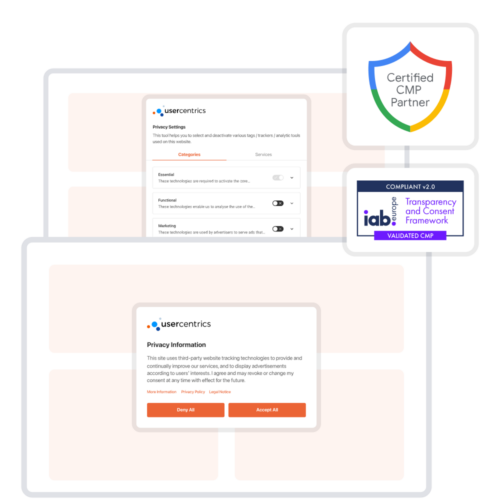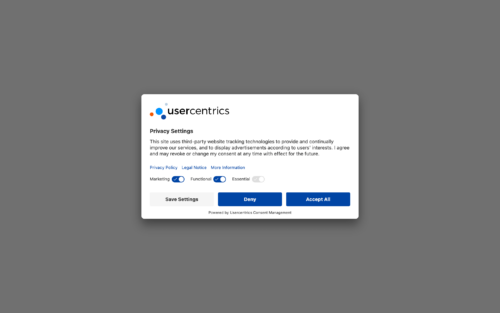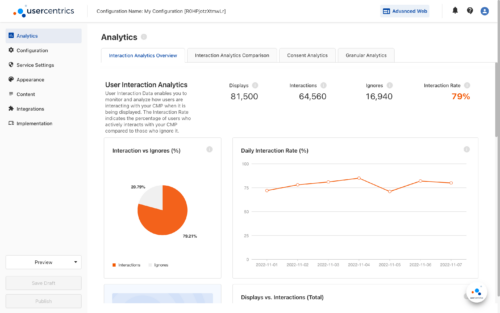Along with an increasing number of regulatory requirements, with Google’s new consent requirements as of March 2024, digital marketing practices need to change. To meet today’s requirements, most of the time marketers need explicit user consent to access individuals’ personal data. Consent-based marketing is effectively becoming the industry standard.
Many marketers strongly rely on Google services as sources for lead generation, retargeting, and customer acquisition. Shifts in data sources and requirements for explicit user consent are directly affecting many digital marketing KPIs, including conversion rates and lead volumes. Consent-based marketing is the way forward, because old strategies and tactics increasingly don’t work — literally — as Google will block companies from fully accessing their services if they can’t signal valid user consent.
We explain what consent-based marketing is, how to obtain user consent easily and in compliance with regulatory requirements, and how to leverage consented data to support and enhance your digital marketing activities.
What is consent-based marketing?
Consent-based marketing is a part of the broader strategy of privacy-led marketing. It involves, for example, only serving ad content to users who have given prior consent for use of their personal data, like saying “yes” to tracking tags on websites.
Data privacy laws and requirements for companies to obtain valid user consent create demand for compliance solutions like the Usercentrics Consent Management Platform (CMP). But the bigger user-centric paradigm shift is that user consent is no longer merely a legal requirement where companies do the minimal work required to avoid getting in trouble. It needs to be factored into the core of marketing strategies and KPIs as we move forward. Companies that thrive will be those that embrace consent and what it can do to build trust and engagement with customers and new audiences.
Why your ad revenue now relies on consent
Consent-based marketing in digital advertising involves clearly asking users for permission to show ads that have been individually targeted for them based on their personal data.
To do this, companies rely on technologies that can automate the user consent transaction and integrate it across marketing tools and platforms. The consent to data collection to analysis to personalization process can easily be made smooth, automated, compliant, and qualified This results in highly engaging, personalized marketing content for the user — who has given explicitly and potentially granularly specific consent to receiving this targeted material.
On the surface, digital marketing is at a challenging crossroads between consumer demand for personalized marketing and consumers’ increasingly worry about how companies handle their personal data. Fortunately, both trends point to the same solution: consent.
Why marketing needs to embrace privacy by design
Consent-based marketing has a privacy by design approach that helps ensure compliance with major data privacy laws around the world, from the GDPR and CCPA/CPRA to the Digital Markets Act (DMA). But that’s just one benefit.
Securing consent creates opportunities to provide better user experience, to serve highly personalized ad content to users who explicitly agree to it, as well as to deliver targeted strategies like account-based marketing (ABM). Giving people what they expressly want helps increase engagement over time.
For those who practice account-based marketing, the GDPR has always been the data privacy elephant in the room. But when consent is baked into all marketing communication, you can rest assured your ABM tactics are privacy-compliant.
Big tech platforms are driving consent-centric change
Many marketers are still dependent on dominant technology platforms like Google and Meta for activities like lead generation and customer acquisition. This creates new challenges, though, given regulations like the DMA, EU rulings, and the end of third-party cookies. There are inescapable signs that things are changing. Even if companies haven’t been particularly concerned about their GDPR compliance, for example, they are concerned about potentially losing their digital ad revenue.
Consent-based marketing vs permission marketing
While similar, there are a few key differences between consent-based marketing and permission marketing (or permission-based marketing).
What is permission marketing?
Popularized by Seth Godin’s 1999 book Permission Marketing: Turning Strangers Into Friends, and Friends into Customers, permission marketing predates many modern data privacy regulations by many years.
The concepts are straightforward and involve asking users for their permission to include them in a specific marketing activity, like a newsletter or rewards program. Simply asking for a prospect’s email address counts as permission-based marketing, although there are no clear obligations for the company for how that email will be stored.
How is consent-based marketing different from permission marketing?
Consent-based marketing reflects today’s data privacy-conscious digital landscape. Secure, ethical, and transparent requests for use of customer data are the starting point from which more welcome and personalized marketing activities can follow.
Consent-based marketing also includes more kinds of activities: tailored website experiences, targeted advertising, more relevant content — the sky’s the limit.
In short, permission marketing is a specific tactic, whereas consent-based marketing is a foundational strategy that informs all digital marketing activities.
Benefits of consent-based marketing
Now that you’re up to speed with what consent-based marketing is and how it’s distinct, let’s explore some of its top benefits.
Enhanced personalization
By obtaining explicit consent to collect and use data, and by employing tactics like preference management to obtain specific consented information directly from customers, you can tailor personalized marketing communications across brand touchpoints. This approach leads to higher engagement rates, as content and offers are more relevant to each individual’s interests and needs.
Improved data quality
When consumers actively choose to share their information, including directly when asked, or by giving permission for personal data collection and use, the resulting data collected is more accurate and valuable. This leads to better insights and strategies, as well as happier customers, as the information is based on genuine interests and behaviors.
Stronger brand reputation
Adopting a consent-based approach demonstrates your brand’s commitment to respecting data privacy and ethical practices for its use. This reflects well on your brand, especially during a time when consumers are increasingly willing to refuse to do business with companies they don’t trust. Giving customers and prospects control over their personal data builds loyalty and trust.
Achieve and maintain regulatory compliance
With the increasing number and complexity of data protection laws worldwide, consent-based marketing helps ensure that your marketing practices comply with consent requirements. This includes opt-in laws like the GDPR, opt-out laws like the CCPA/CPRA, or third-party requirements levied by companies like Google and Facebook as a result of the DMA. Obtaining valid consent enables you to avoid potential fines, loss of platform access and audiences, and reassures customers that their data is being handled responsibly.
Higher engagement and conversion rates
Consumers are more likely to engage with marketing messages when they have agreed to receive them, and the messaging matches their requested format and expressed interests. This consent shows direct interest in your brand, which can enhance lead data and result in better conversion rates.
Reduce marketing costs
By targeting only those who have expressed interest in your products or services, in the ways they want to hear from you, with the content they’ve told you they want, you can allocate your marketing budget more efficiently. This targeted approach can increase the ROI of your marketing campaigns and provide even better insights for further future optimization.
Why should marketers care about data privacy compliance?
While users want more personalization, they will generally only give their data to companies they trust to protect it. Privacy laws also increasingly provide consumers with the right to portability, enabling customers to take their data with them — potentially to a competitor. Companies need marketing consent from users to operate within the law; to deliver the products, services and experiences that customers want; and to protect and grow their market share in highly competitive markets.
As the industry changes from reliance on third-party to first-party data, marketers are looking for ways to minimize their dependence on mass data collection and discover new ways to engage customers in ways that are cost effective, accurate, and sustainable in addition to complying with the law and building user trust.
Consumers are driving privacy and marketing changes
Trends show that data privacy awareness is increasingly driving consumer decisions. Laws like the DMA also work to enable a more level playing field and better competition in digital markets, requiring companies to step up their game to attract and retain customers. As a result, the benefits of consent-based marketing go beyond regulatory compliance. According to a 2021 study by Cisco:
- 79% of consumers say that data privacy is a buying factor for them
- 47% of consumers say they have switched companies over a company’s data policies or data-sharing practices
- 19% of consumers say they have terminated a relationship with a retailer, ecommerce website, or online business over their data policies or data-sharing practices
Plus, explicit marketing consent makes lead data more valuable and usable for retargeting and user acquisition, increasing your marketing opportunities.
Reliance on big tech platforms for marketing operations has risks
In January 2023, Meta was fined EUR 390 million by EU authorities for including the user consent transaction in their terms of service agreements. Large platforms also have outsize control over advertising, providing data, audience access, and other critical marketing functions. Relying on big tech as a main source for lead generation is becoming riskier. It’s important for companies to take charge and do everything they can to ensure their marketing operations comply with relevant laws.
In short, marketers need to meet the new requirements brought about by regulations, but they also need new strategies to match the changing legal and technological landscape.
But what does it actually mean to be privacy-compliant? How do you secure consent from users in the right way?
Privacy-compliant marketing in four simple steps
Navigating data privacy regulations while simultaneously optimizing marketing activity can seem daunting, especially with global business operations that may require compliance with more than one law. But it’s pretty simple with the right tools and knowledge. Here are four steps to achieve privacy-compliant marketing.
Step 1: Collect explicit consent from your audiences across all channels
A consent management platform (CMP) enables easy automation of the entire process of obtaining, documenting, and securely storing user consent. That’s why CMPs are a preferred solution for most website administrators and executives as opposed to building a consent solution themselves.
Step 2: Document consent for compliance and consumers
Keep a secure record of when and how users consent to marketing and their information being used, along with the specific circumstances and use cases where their consent applies. Ensure people can change or revoke their consent in the future as well.
This is crucial, as various data privacy regulations — including the GDPR — require businesses to show evidence of consent in the event of an audit, customer dispute, or data subject access request.
Step 3: Ensure that your marketing tech stack is GDPR-compliant
To do consent-based marketing well, you’ll need a well-integrated tech stack. This should start with a high performance CMP that makes the consent transaction effortless for both users and the company, while ensuring legal compliance under relevant data privacy laws. The GDPR doesn’t apply to all companies or consumers, but it’s among the most stringent of privacy regulations, so compliance helps ensure privacy best practices anywhere in the world.
Once obtained, your CMP should enable signaling of consent information to other systems and tools in the marketing tech stack, and control access to user data by those as well as by third parties, e.g. partners and vendors. The CMP should also be resource-efficient and easy for your team to implement and maintain.
Here’s a checklist for your GDPR compliance:
- Consent must be obtained from users before any activation of cookies or other trackers (apart from whitelisted, necessary cookies).
- Granular consent must enable users to activate some cookie categories and not others.
- Consent must be freely given, without nudging or coercing the user in any way.
- Users must be able to withdraw or change consent as easily as they gave it.
- Evidence of consent must be securely stored as legal documentation.
- Consent must be renewed at least once per year, though some national data protection guidelines recommend more frequent renewal — like every six months — so check your local data protection guidelines for compliance requirements.
- Privacy regulations and business requirements are evolving, so ensure notifications and options provided to users are kept up to date (ideally via and automated solution).
Any comprehensive consent management platform should be able to handle all of the above with full automation, so you can focus on wider consent-based marketing strategies.
Get our comprehensive GDPR compliance checklist for your marketing operations.
Tools for a consent-based marketing tech stack
Other tools for your consent-based marketing tech stack include:
- Google Consent Mode can help you streamline user consent across many services (like Google Ads and Google Tag Manager), providing valuable measurements and data even if users don’t give explicit consent.
- Other tools Google recommends:
- Customer Match enables you to deliver more targeted ads using online and offline data.
- Enhanced Conversions improves your conversion measurement using hashed first-party conversion data, so you can bid more effectively.
- GA4 with Consent Mode helps manage cookies for analytics and measuring campaign performance across your websites and apps.
- Usercentrics Preference Manager enables you to collect in-depth user permission and preference information, store them securely in a centralized location, and sync them across your favorite marketing tools.
- Server-side tagging tools, available as a Usercentrics CMP product extension, can help you move to a more secure alternative to third-party cookies.
- Marketing automation tools like Dashly or Drift can help with conversational marketing activities, e.g. personalization of communications.
- CMSes like HubSpot can help you craft more personalized and flexible marketing content for users.
- Tools for video marketing like TubeRanker can help you optimize video content and gain higher rankings on Google and YouTube.
Step 4: Optimize your data use
Digital markets that are structured around the transaction of consent are growing. Data privacy puts consumers in control and provides clear benefits for both them and the companies with which they do business. New innovations are meeting the challenges of the transition from the third-party cookie era to the era of zero- and first-party data and consent.
For marketers, this change means, in part, moving away from high-volume but generic marketing strategies toward more personalized activities and customer relationships.
A shift from mass data collection to quality data obtained with consent
One of the biggest challenges facing marketers is how to leverage user consent to qualify and optimize your company’s marketing strategy, rather than simply losing data from users who don’t provide consent.
While consent-based marketing can seem like a limited approach, this is only because we’re used to mass data collection by third-party tech, where user consent was considered optional, if it was considered at all. Newer tools like Google Consent Mode do enable modeling to help marketers gain information and insights even when there are users who do not consent.
Automate consent management with Usercentrics
Usercentrics CMPs for websites and for mobile apps deliver industry-leading consent and privacy compliance solutions that can help automate regulatory complexities for your business.
Our products deliver easy automation and granular customization to fit your brand while handling ever-changing legal complexity. This customizability offers ways to optimize consent rates with increased user trust and better user experience, and balance data privacy with the growth of data-driven business.
Usercentrics enables control of your website’s data processing through unrivaled scanning technology, user-friendly consent management, and reliable and scalable tech and legal expertise.
Is your website privacy-compliant?
Usercentrics’ data privacy audit checks your website to determine current data privacy compliance risk level
When users interact with the CMP, it documents and maintains consent information with regular renewal (as the GDPR requires). Usercentrics also enables compliance with California’s CCPA, South Africa’s POPIA, Brazil’s LGPD, and more.
Our consent management platform integrates seamlessly as a Google-certified partner for Google Consent Mode, enabling consent to be seamlessly signaled to Google services, benefiting both the consumer and marketers across the marketing tech stack. Plus, integrations with WordPress, HubSpot, Google Tag Manager and many more help make GDPR compliance an easy and integrated part of your consent-based marketing strategies.
Still have questions about consent-based marketing and how to achieve and maintain data privacy compliance? We’re here to help.
FAQs
What is the consent process in marketing?
As a result of implementation of data privacy regulations like the GDPR, digital marketers now need explicit user consent to use personal data in many regions for most purposes.
Marketers need to follow stringent processes where data subjects either explicitly opt in (as required by the GDPR) or opt out (as required by the CCPA) for various forms of personal data collection and use. This involves presenting a clear and detailed request at the point of data collection.
Depending on which regulations apply, this request may also include:
- data and how it will be collected
- purpose(s) for data collection
- the legal basis for data collection
- insights on who will have access to the data
- how data will be stored
- information on users’ data privacy rights and how to exercise them
- a “Do Not Sell or Share My Personal Information” link
- an option to change or revoke previously granted consent
- a mechanism to make a data subject access request or appeal a request rejection
- contact information for the company
What are the benefits of consent marketing?
In addition to enabling compliance with global data protection requirements and avoiding costly penalties, consent marketing promotes trust with consumers, who are increasingly aware of their data protection rights and willing to exercise them, which affects companies’ bottom line.
With a seamless and privacy-compliant consent process integrated into digital marketing efforts, businesses have better data quality and users are served with marketing content that’s more interesting and engaging to the individual. It also lays the foundation for users to enjoy personalized interactions with businesses, such as tailored website experiences.
This results in better marketing outcomes, such as a boost in engagement and conversion, as well as more effective marketing spend.
What are the steps involved in consent-based marketing?
There are four key steps involved in consent-based marketing.
- Collect explicit consent across all marketing channels: A solution like Usercentrics CMP will automate obtaining, documenting, and storing user consent for you.
- Document consent for compliance: Keep comprehensive records of user consent, and all relevant information surrounding a consent request, such as when it was obtained or updated and the legal basis for data collection.
- Ensure marketing tools and technology comply with the GDPR or other privacy laws: You need a tool like a CMP that will ensure clear, granular consent is given before any tracking occurs, and that comprehensive evidence of consent information is securely stored and available in case of audit or a data subject access request (DSAR).
- Optimize data use and collection: Adopt the shift to zero- and first-party data collection and use, ensure your marketing strategies and KPIs are built around this new approach to user consent and personalized targeting.
How can businesses ensure privacy compliance with consent-based marketing?
Consent-based marketing involves a privacy by design approach. By building marketing strategies and approaches around consent, businesses will be set up to meet stringent new legal and business requirements, which include obtaining explicit user consent before any targeting marketing activities can take place.
To achieve this, companies need technologies like a CMP, to automate the process of securely obtaining, storing, documenting, and signaling user consent.



